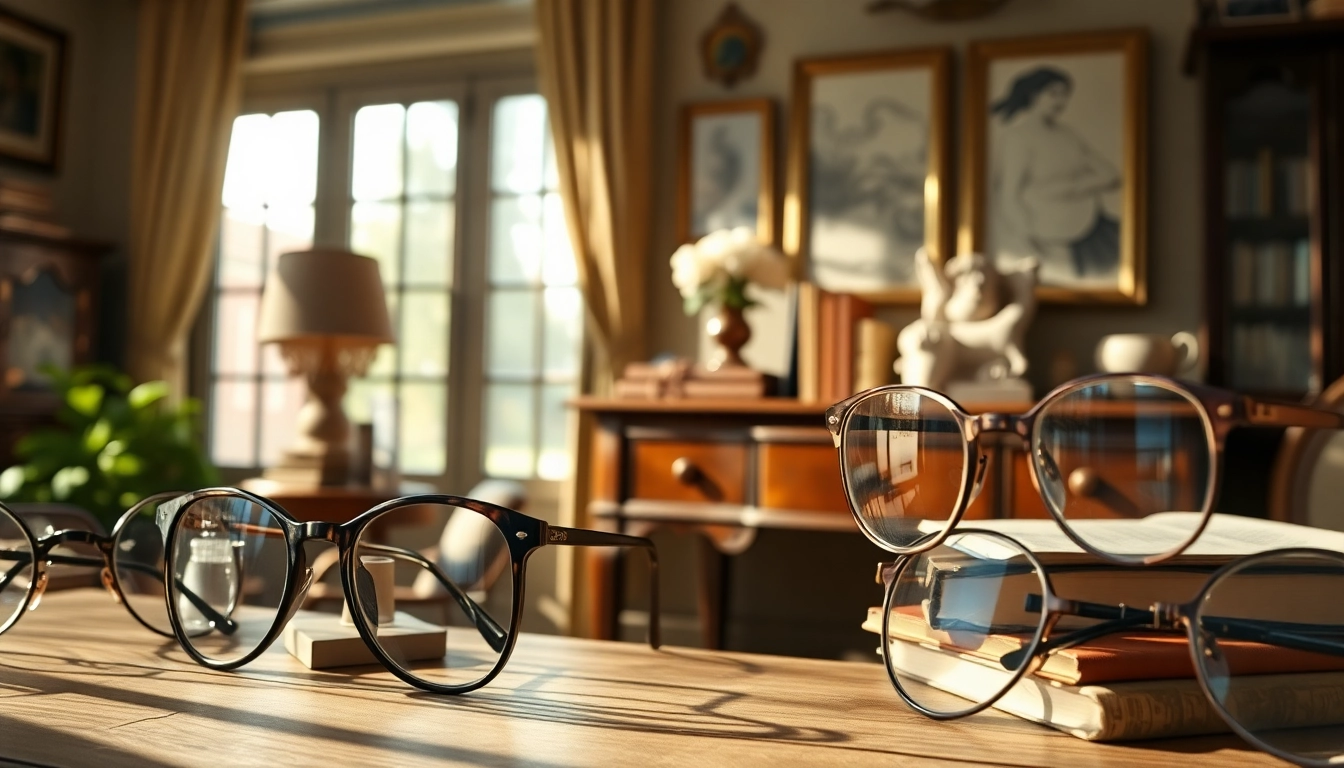Understanding Vintage Frames
What Defines Vintage Frames?
Vintage frames are more than just old eyeglass structures; they encapsulate unique styles from bygone eras, bringing a sense of nostalgia and individuality to today’s fashion. Specifically, a frame typically qualifies as “vintage” if it is at least 20 years old and often reflects the design aesthetics from the 1930s to the early 2000s. These frames can be made from various materials, such as metal, plastic, or wood, and frequently feature intricate details that were popular in their respective periods. Quality craftsmanship is another hallmark of vintage frames, differentiating them from contemporary mass-produced eyewear. Many present-day enthusiasts choose to wear vintage frames as a statement of personal style, often searching for those unique designs that express their individuality.
The History and Evolution of Vintage Eyewear
To appreciate vintage frames fully, one must delve into the history of eyewear. The origins of spectacles can be traced back to the 13th century, but it wasn’t until the 18th century that the designs began to evolve significantly. During the 1920s, with the advent of the Art Deco movement, eyewear became not just functional but also a crucial accessory for fashion-conscious individuals. As the decades rolled on, so did the experimentation with shapes, colors, and materials. The 1950s introduced cat-eye glasses, while the 1970s saw the rise of oversized frames and the emergence of colorful plastic glasses. Each era contributed a distinctive flair to eyewear, pouring rich cultural influences into the design. By the time we reached the 1990s and early 2000s, eyewear had morphed into a vast spectrum of styles, from grunge-inspired thick frames to sleek minimalist designs, showcasing an ever-evolving relationship with fashion.
Popular Styles of Vintage Frames
Throughout history, various styles of vintage frames have made significant impacts on eyewear trends. Among the most sought-after styles are:
- Cat-Eye Frames: Characterized by their upswept outer edges, cat-eye sunglasses gained popularity in the 1950s and 1960s, making them an enduring icon of feminine allure.
- Wayfarers: Introduced in the 1950s, Wayfarers became an instant classic. Suitable for both men and women, their unique shape offers a timeless appeal.
- Round Frames: These frames hark back to early 20th-century styles and saw a resurgence among artists and intellectuals, symbolizing a bohemian lifestyle.
- Aviators: Initially designed for pilots, this style gained immense popularity in the 1970s and is now synonymous with cool, laid-back attitudes.
- Oversized Frames: Dominating the 1970s fashion scene, oversized sunglasses offer an exaggerated style paired with ample UV protection.
Choosing the Right Vintage Frame for You
Factors to Consider When Selecting Vintage Frames
Choosing the perfect vintage frame goes beyond aesthetics; there are several vital factors to consider:
- Face Shape: Identifying your face shape—round, square, oval, or heart-shaped—will guide you toward frames that enhance your features. For instance, cat-eye frames can accentuate the cheekbones of heart-shaped faces, while rectangular frames often complement round faces.
- Color: Opt for colors that align with your personal style and match your skin tone. Neutral colors are versatile and can be paired with various outfits, while bold colors can serve as focal points.
- Material: Consider the material’s weight and comfort. Metal frames tend to be lighter, while plastic options can offer vibrant colors. Additionally, check for any allergies to materials that might affect wearability.
- Fit: Ensure the frame properly aligns with your size. An ill-fitting frame can cause discomfort and detract from your overall appearance. Ensure the frames sit comfortably on your nose and do not slide down or pinch.
How to Match Vintage Frames with Outfits
Integrating vintage frames into your wardrobe can elevate your style dramatically. Here are some tips to help you pair them effectively:
- Keep It Simple: If your ensemble is already bold, opt for frames with a more subdued design to maintain a balanced look.
- Consider the Occasion: For casual outings, a playful pair of round frames can offer a whimsical touch, whereas sophisticated events may call for sleek cat-eye or aviator styles.
- Play with Layers: For layered outfits, integrate frames that resonate with your clothing’s overall vibe, whether it’s vintage, modern, or eclectic.
- Accessorize Wisely: Combine with other vintage accessories, like scarves or hats, to create a cohesive look.
Assessing Quality and Authenticity of Vintage Frames
When investing in vintage frames, it’s vital to ensure their authenticity and quality. Consider the following:
- Brand Recognition: Familiarize yourself with reputable vintage brands known for quality materials and craftsmanship, such as Ray-Ban or Persol.
- Inspect the Condition: Look for any signs of wear, such as scratches or rust, which may indicate poor preservation. Look closely at the hinges and any embellishments for quality assurance.
- Check for Labels: Identify tags or etched names that signify the brand or production details. Authentic vintage items may have markings that offer insight into their origins.
- Seek Expert Opinions: If unsure, consult with vintage eyewear specialists who can offer their expertise in authenticity verification.
Decorating with Vintage Frames
Clever Ways to Use Vintage Frames in Home Decor
Beyond eyewear, vintage frames can be repurposed as decorative elements within your home. Here are inventive uses:
- Artwork Displays: Create a striking gallery wall by framing artwork, photographs, or fabric within various vintage frames—mix and match for an eclectic look.
- Mirrors: Utilize larger frames to create unique mirrors, enhancing wall space while providing functional decor.
- Message Boards: Insert burlap or corkboard within the frame, allowing it to serve as a charming message board or to-do list for your kitchen or office.
Creating a Gallery Wall with Vintage Frames
Designing a gallery wall with vintage frames adds a personal touch to any space. Here are steps to help you create a captivating display:
- Select Your Space: Choose a wall that can accommodate the display and preferably acts as a focal point in the room.
- Gather Your Frames: Collect a diverse range of frames in various styles and sizes for an eclectic aesthetic.
- Lay Out Your Design: Before hammering any nails, arrange the frames on the floor to visualize how they will look on the wall.
- Hang with Care: Use appropriate hardware based on the frame weights, ensuring they are level and spaced harmoniously.
Incorporating Vintage Frames in Modern Spaces
Vintage frames can seamlessly blend into modern decor, creating a unique contrast. Here’s how:
- Mixing Styles: Pair vintage frames with contemporary furniture to create a visual contrast while still feeling cohesive.
- Accent Pieces: Use smaller frames as centerpieces on tables or bookshelves to add character to modern spaces without overwhelming them.
- Consistent Color Palette: Ensure that the frames share colors with other elements in the room to maintain a unified appearance.
Maintaining and Caring for Vintage Frames
Cleaning and Preserving Vintage Frames
To keep your vintage frames in excellent condition, regular maintenance is essential. Here’s how:
- Regular Dusting: Gently dust frames with a soft, dry cloth to prevent dirt accumulation and maintain shine.
- Use Appropriate Cleaners: When needed, use mild soap and water or a specific optical lens cleaner to avoid damaging the finish.
- Store Properly: When not in use, store frames upright in a protective case to avoid scratches or breakage.
Storage Tips for Vintage Eyewear
Proper storage is crucial in maintaining the integrity of vintage eyewear:
- Use a Pouch or Case: Always store your vintage frames in a protective pouch or case, especially when traveling.
- Avoid Heat Exposure: Keep eyewear away from heat sources, as excessive heat can warp frames.
- Designate a Specific Spot: Have a designated area in your home to keep your vintage eyewear organized and accessible.
Repairing Damaged Vintage Frames
Damage to vintage frames does not mean they are beyond repair. Consider these options:
- Professional Repair: Take severely damaged frames to an expert who specializes in vintage eyewear repair to restore them carefully.
- DIY Repairs: For minor issues, like tightening screws or replacing nose pads, simple tools can help with quick fixes.
- Replacement Parts: Search for authentic replacement parts on marketplaces dedicated to vintage eyewear to preserve the frame’s authenticity.
Where to Find Authentic Vintage Frames
Best Online Resources for Vintage Frames
Finding genuine vintage frames has never been easier, thanks to the internet. Here are some reliable online sources:
- Etsy: A marketplace filled with unique offerings, including handcrafted and vintage eyewear.
- eBay: A go-to platform for antique collectible frames, where you can discover a vast array of options.
- Specialty Websites: Check out sites like Vintage frames for niche collections and quality selections.
Visiting Antique Shops and Flea Markets
Physical visits to antique shops and flea markets can yield hidden treasures. Here are tips to maximize your finds:
- Be Patient: Finding the perfect frame may take time, but persistence often leads to great discoveries.
- Inspect Thoroughly: Check for quality and structural integrity; don’t hesitate to ask vendors questions about the frames’ origins.
Understanding the Pricing of Vintage Frames
Pricing for vintage frames can dramatically vary based on several factors:
- Condition: Well-preserved frames generally command higher prices.
- Brand: Recognized and sought-after brands can lead to premium pricing.
- Rarity: Limited edition frames or those with unique designs may fetch more on the market.



